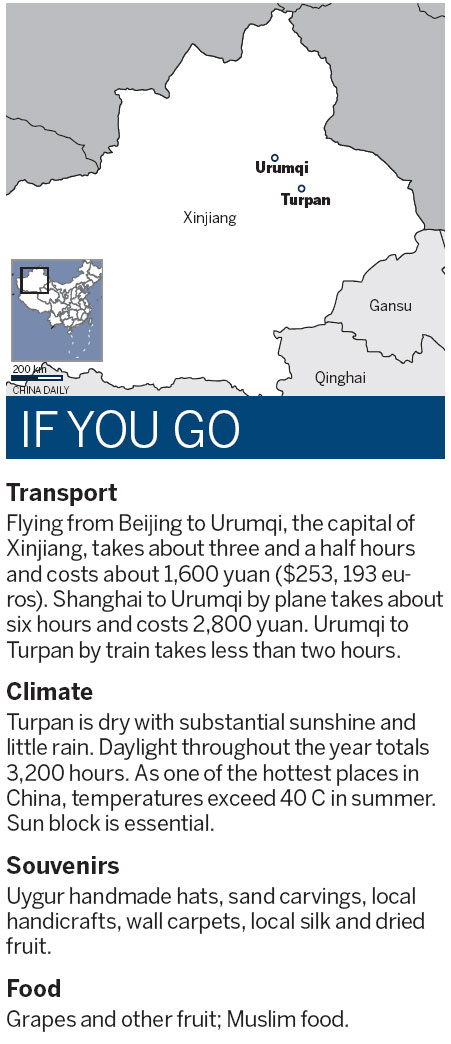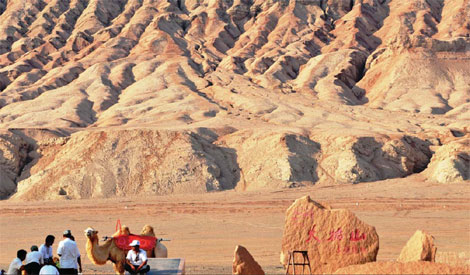Hot spot
Updated: 2012-03-16 07:31
(China Daily)
|
|||||||||||
|
The flaming mountains count as one of the hottest places in China with their arid appearance. Jiang Xiaoming / For China Daily |
Oasis offers some of the best of China's west
Turpan is one of the hottest places in China. Summer temperatures in the city in the Xinjiang Uygur autonomous region can approach 50 C, but an ingenious irrigation system and excellent location made it an important oasis for the caravans of the ancient Silk Road and a major crossroad for the ancient Chinese, Indian, Islamic and Greek civilizations.
This historic trading hub for East and West sits at the Turpan Basin, one of the world's lowest surface points, and its geographical attractions range from expansive deserts to the snow-capped mountains of Tianshan.
The Uygur ethnic group makes up most of the population in Turpan. The city has a long history, with written records going back more than four millennia, making it a political, economic and cultural center of the western regions.
Major tourist attractions include:
1. The Flaming Mountains
The mountains lie northeast of Turpan, with the main peak reaching up to 830 meters. During the summer, hot air currents rise to distort the appearance of the eroded, reddish-brown slopes and make them seem as if they are burning.
The flaming mountains are well known in China through the literary classic Journey to the West, in which one of the main characters, Monkey, makes three attempts to borrow a magical fan from Princess Iron Fan to put out the flaming obstacle.
The site counts as one of the hottest places in the country and is devoid of plants on the surface. But there are also green valleys in spots in the mountainsides as a result of geographical movement and rivers - and one of these green spots includes the Grape Valley.
2. The Grape Valley
The valley lies at the western side of the Flaming Mountains and is considered a paradise offering various kinds of fruits and melons, especially countless varieties of grapes. Visitors can walk under grape trellises and pick the fruit themselves.
The Grape Valley is an ideal resting spot for summer as temperatures can be about 10 C lower than those in downtown Turpan. More than 6,000 people from Uygur, Hui and Han ethnic groups live here.
3. The Karez Well
The Karez Well is a special groundwater system used for irrigation and drinking in the desert region.
The wells, which are mostly connected by underground canals to direct runoff from the mountain ranges by making use of gravity within the basin and prevent the water from evaporating in the high temperatures, have been a crucial factor behind the development of oases in the Turpan Basin.
The number of Karez wells in the area has peaked at more than 1,000, with a network that stretched about 5,000 kilometers.
The Karez Well counts as one of the most important water systems in China and has been honored as one of the three great projects in ancient China along with the Great Wall and the Beijing-Hangzhou Grand Canal.
Turpan's irrigation system complements its dry and hot climate to make it extremely suitable for growing sweet fruit, earning the city the reputation of "the hometown of grapes and melons".
For the past two decade, the Silk Road Turpan Grape Festival has been delighting residents and visitors every August.
4. The ancient city ruins of Gaochang
Gaochang was the capital of the Gaochang kingdom and built during the 1st century BC. It is the largest ancient city relic in the western regions.
The city covers more than 2 million square meters. The existing Gaochang city remnants consist of three parts - the outer city, the inner city, and the palace. The city experienced more than 1,300 years of changes and was burnt down during wars in the 14th century.
Outside the city, there is a large Buddhist monastery covering nearly 10,000 square meters. Relics of murals can be found on the wall of the main hall.
Xuanzang, the monk who traveled to India to obtain Buddhist scriptures during the Tang Dynasty (AD 618-907), is said to have lectured here.
Relics of households and marketplaces can be found in Gaochang.
5. The Bezelik Thousand Buddha Caves
The caves are built on the cliffs of the western bank of Mutou Valley at the foot of the Flaming Mountains. It was developed in the Gaochang Kingdom Period (AD 499-640 ).
The caves are famous for their murals, which can still be found in about 40 of the 57 existing caves, covering an area of 1,200 square meters.
The caves were severely damaged in religious clashes and looting in the early stages of the last century. But the remaining statues and murals are still magnificent, delicate and colorful.

Today's Top News
Rescuers race against time for quake victims
Telecom workers restore links
Coal mine blast kills 18 in Jilin
Intl scholarship puts China on the map
More bird flu patients discharged
Gold loses sheen, but still a safe bet
US 'turns blind eye to human rights'
Telecom workers restore links
Hot Topics
Lunar probe , China growth forecasts, Emission rules get tougher, China seen through 'colored lens', International board,
Editor's Picks

|

|

|

|

|

|






